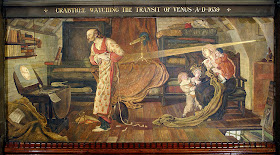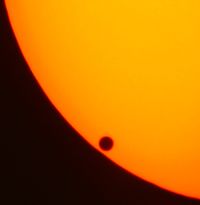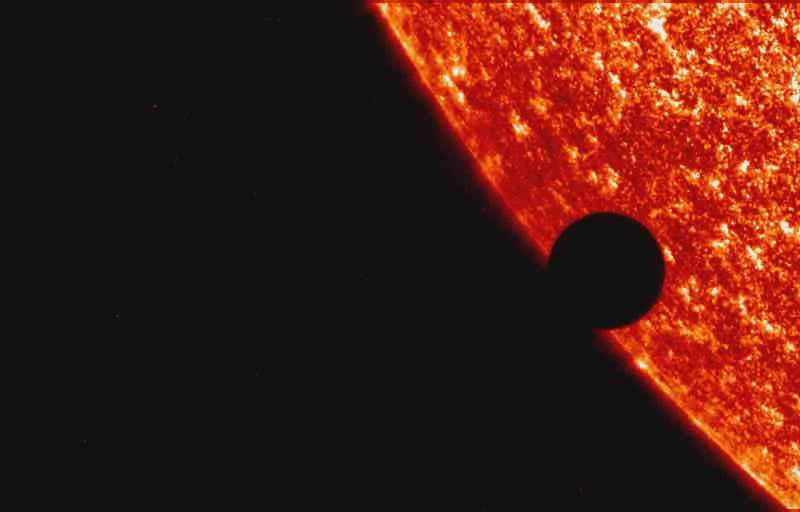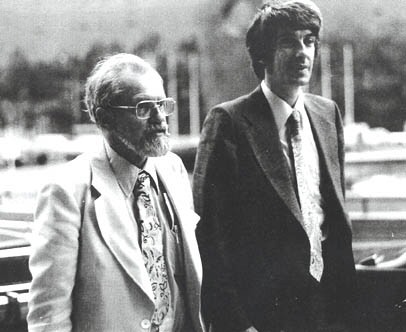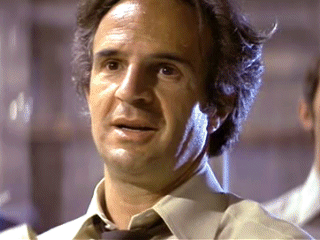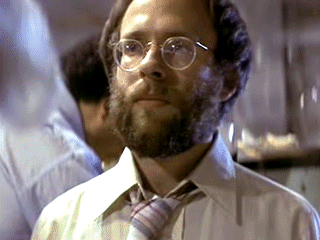A drawing of the 1631 eruption of Mt. Vesuvius
by Glovan Batista Passaro.
by Glovan Batista Passaro.
The December 7, 1631 Transit of Venus was followed on December 16th by a violent, unexpected eruption of Mt. Vesuvius beginning around 6:00 am. Vesivius have been inactive for a great deal of time, probably since 1139. During the night of December 16-17, earthquakes occurred every 1-15 minutes. At about 11:00 am on the 17th, a large mass of ash, gas, and stones flowed down all sides of Vesuvius, causing the liquefaction of the mountain. Ten minutes later, a tsunami up to 6 to 15 feet of height hit the coast. By 6:00 pm on December 17th, the decline of activity began, lasting several days. The death toll was variously reported to be 3000 to 6000 deceased individuals in Pompeii and other locations.
A Transit of Venus across the Sun takes place when the planet Venus passes directly between the Sun and Earth, obscuring a small portion of the solar disk. During a transit, Venus can be seen from Earth as a small black disk moving across the face of the Sun. The duration of such transits is usually measured in hours (the transit of 2004 lasted six hours).
Crabtree watching the Transit of Venus A.D. 1639
by Ford Madox Brown, a mural at Manchester Town Hall
The first known observation of a transit of Venus was made by Jeremiah Horrocks from his home at Carr House in Much Hoole, near Preston in England, on December 4, 1639 (November 24th under the Julian calendar then in use in England). His friend, William Crabtree, also observed this transit from Broughton, near Manchester. Horrocks and Crabtree were founding members of "Nos Keplari." Horrocks died mysteriously two years later, at the age of 22.
Charles Mason (1730-1786), astronomer, and Jeremiah Dixon, (1733-1779), surveyor and astronomer, are best known for giving their name to the Mason-Dixon line in the United States of America. But their biographies are interwoven with their viewing of two Transits of Venus in 1761 and 1769.
In 1760 the Royal Society chose Charles Mason to go to Sumatra to observe the 1761 transit of Venus, and, probably on Bird's recommendation, Mason suggested Dixon should go as his assistant. An encounter with a French frigate delayed their final sailing so that they could not reach Sumatra in time. They therefore landed at the Cape of Good Hope, where the transit was successfully observed on 6 June 1761….
Mason and Dixon eventually reached England early in 1762. In August 1763 Mason and Dixon signed an agreement with Thomas Penn and Frederick Calvert, seventh Baron Baltimore [qq.v.], hereditary proprietors of the provinces of Pennsylvania and Maryland, to go to North America to help local surveyors define the disputed boundary between the two provinces. Arriving in Philadelphia with their instruments in November, they began operations before Christmas 1763. When work for the proprietors on what was to become the famous Mason-Dixon line was complete late in 1766, they began on the Royal Society's behalf, at Dixon's suggestion, to measure a degree of the meridian on the Delmarva peninsula in Maryland and to make gravity measurements with a clock sent out by the Society, the same one that Maskelyne had had in St Helena and Dixon took to the Cape in 1761. They reported their task complete on 21 June 1768 and sailed for England on 11 September. Before leaving, they were both admitted as corresponding members of the American Society held in Philadelphia for Promoting Useful Knowledge.
In 1769 Dixon sailed to Norway with William Bayly in the Emerald to make observations of the transit of Venus on 3 June on the Royal Society's behalf. Dixon observed on Hammerfest Island, Bayly at North Cape, about sixty miles apart in case of cloudy weather. They reached England again on 30 July. Dixon returned to Durham, resuming his work as a surveyor. Among places he surveyed at this time were the park of Auckland Castle and Lanchester Common. He died [at age 55] unmarried in Cockfield, county Durham, 22 January 1779.
…
Mason was employed by the Royal Society during six months in 1769 on an astronomical mission at Cavan in Ireland. He observed the second transit of Venus on 3 June, partial solar eclipse of 4 June, the phenomona of Jupiter's satellites, and in August and September the famous comet which signalised the birth year of Napoleon Bonaparte....He returned to America, and died in Philadelphia in 1787. His journals were almost tossed, also found a certificate of admission into American Society of Philadelphia. Dixon was reportedly born in a coal mine, died [at 46] at Durham in 1777. ~ Oxford University Press Dictionary of National Biography
The above drawing was created, partially, in anticipation of the Transit of Venus of December 9, 1874. Bob Rickard, editor of Fortean Times, writes me: "This is an illustration from Harry Price's Poltergeist over England (1945) and is a satirical comment on the alleged teleportation of the medium Mrs. Guppy during a poltergeist haunting in London in 1871."
Transit of Venus, December 1882
Freemason John Philip Sousa's Transit of Venus was composed after the Transit of 1882 (pictured). See here for more synchromystic details related to Sousa.After 1882, the next Transit of Venus was not until June 8, 2004. What notable events are associated with that Transit? Days before it occurred, on June 4th, Ronald Reagan, American actor, 40th President of the United States (b. 1911), and officially a Scottish Rite Mason, died. On June 8th, during the Transit, the 30th G8 summit took place on Sea Island, Georgia, USA.
One seemingly strange event was timed exactly for the 2004 Transit of Venus. The heart of the dauphin Louis-Charles, recognized by French royalists as Louis XVII of France, was entombed in the royal crypt of Saint-Denis Basilica outside Paris, 211 years after he perished in the French Revolution. DNA testing had verified the heart as belonging to the son of the guillotined King Louis XVI and Queen Marie Antoinette. No French government officials or members of reigning royal families attended the service.
The Year 2004 is perhaps most remembered for one of the worst natural disasters in recorded history, when the strongest earthquake in 40 years hit the entire Indian Ocean region. The massive 9.3 magnitude earthquake, epicentered just off the west coast of the Indonesian island of Sumatra, generated enormous tsunami waves that crashed into the coastal areas of a number of nations including Thailand, India, Sri Lanka, the Maldives, Malaysia, Myanmar, Bangladesh, and Indonesia. The official death toll in the affected countries is recorded as 186,983, while more than 40,000 people are listed as still missing.
Strange Eye looks at the 17 dates of the previous sixteen Transits, plus the 2012 Transit of Venus.
For 2012, this Transit will be visible in its entirety from Hawaii, Alaska, Australia, the Pacific and eastern Asia, with the beginning of the Transit visible from North America and the end visible from Europe.
Secret Sun had a few visual observations about the forthcoming Transit of Venus, posted a month before the event, here. Etemenanki has his too, and Andrew Griffin, as well.The Transit of Venus will be seen in the USA on June 5, 2012, from about 8 PM EDT until sunset. It will continue be visible during sunrise in the UK on June 6th. The Queen's Diamond Jubilee is on June 2-5, 2012, in the United Kingdom, as noted in "Queen's Diamond Jubilee omens."
What you perceive as happening in the wake of this year's Transit of Venus may not be as euphonious as you have heard in various peace-filled and transformational predictions. Well-known astrologer and former psychotherapist Philip Levine of Sirius Astrological Services shared with me his balanced insights about the upcoming Transit of Venus:
It seems like no big deal that Venus is doing this. One hundred five years is a very short time in the life of planets. And this Sun-Venus conjunction is squared by Mars, so all the harmony and money and love and other Venusian things that one might expect have a fairly loud dissenting voice being thrown into the mix, because Mars squares are about hostility, conflict, aggression, and competition. Such a time would seem to be challenging in terms of finding the best mix of these opposing principles.
Venus, Mars, the Sun...thoughts of a human from a company named Sirius? I can't think of a better guide to a more reasonable way to think about this event.
But what will be the most immediate phantasmagoric space-related imagery that directly follows the 2012 Transit of Venus? Indeed, it may be the June 8th opening in the USA of Ridley Scott's Prometheus, which introduces its new mythos for our beginning, graphically.
Prometheus stole fire from Zeus and gave it to the mortals. What will this movie give to all of us? What will the Transit of Venus presage for tomorrow?
+++
"I do not know how to find out anything new without being offensive. To the ignorant, all things are pure: all knowledge is, or implies, the degradation of something. One who learns of metabolism, looks at a Venus, and realises she's partly rotten. However, she smiles at him, and he renews his ignorance. All things in the sky are pure to those who have no telescopes. But spots on the sun, and lumps on the planets -- and, being a person of learning, or, rather, erudition, myself, I've got to besmirch something, or nobody will believe I am -- and I replace the pure, blue sky with the wormy heavens...."
~ Charles Fort, Lo!

